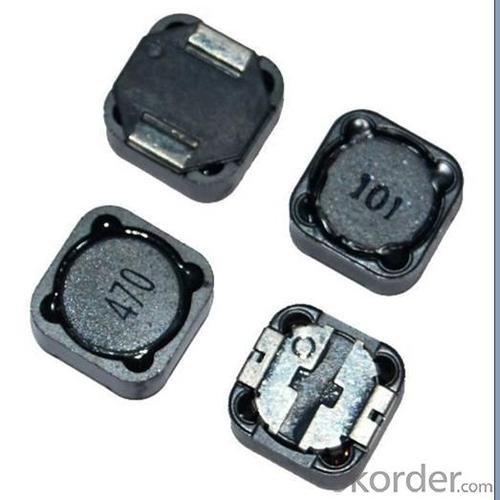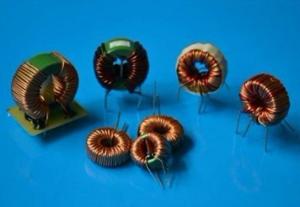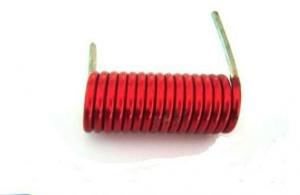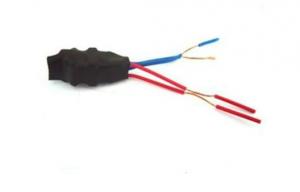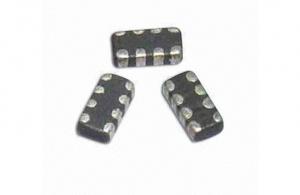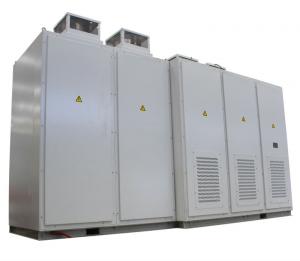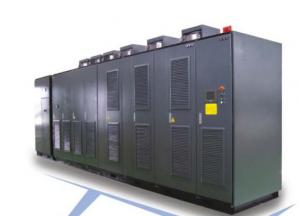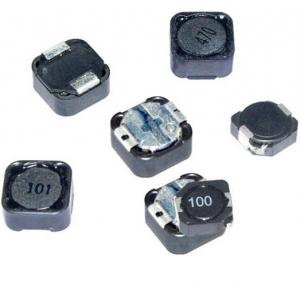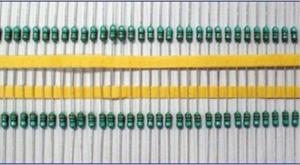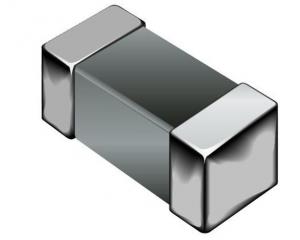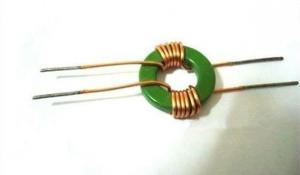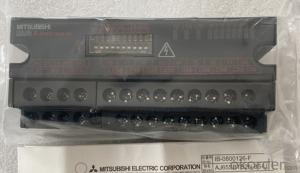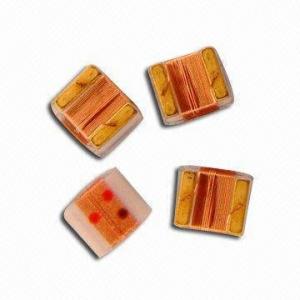PBH Series SMD Power Inductor
- Loading Port:
- China Main Port
- Payment Terms:
- TT or LC
- Min Order Qty:
- 1000 Pieces pc
- Supply Capability:
- 20,000 Pieces per Day pc/month
OKorder Service Pledge
OKorder Financial Service
You Might Also Like
1. pbh series smd power inductor
2. Rated current: 1-10A
3. Inductance0.5~6000uH
4. ROHS
5. competitive price
Features:
1.SMD Power Inductor
2.Magnetic shieled surface mount inductor with high current rabing low D.C resistance
3.Excellent terminal strength
4.Packed in embossed carrier tape and can beused by automatic mounting machine.
5.Various hogh power inductors are superior to be high saturation for suiface mounting.
Applications:
Power supplu for VTR,OA equipment Digital camera, LCD television set notebook PC,
portable communication equip,ents, DC/DC converters, etc.
- Q: A. leads the voltage B. is in phase with the voltage. C. is a square wave D. lags the voltage
- The answer is D; current will lag the voltage. Just remember ELI the ICE man. This is the way I was taught to remember this. ELI, E (voltage) leads I (current) in an inductor (L). ICE, I (current) leads E (voltage) in a capacitor (C).
- Q: Hello, i really need some help solving. please show all steps. i really appreciate it! thanks in advance.An 8.0-mH inductor and a 2.0-Ω resistor are wired in series to a 20-V ideal battery. A switch in the circuit is closed at time 0, at which time the current is zero. After a long time the current in the resistor and current in the inductor are: A) 0,0B) 10A, 10AC) 2.5A, 2.5AD) 10A, 2.5AE) 10A, 0
- Assuming the inductor is a perfect conductor, the as long as the time is very long (t L/R), the current is set by the value of the resistor: I V/r 20/2 10 A. Since this is a series circuit, the current in the resistor and inductor is the same value.
- Q: I always wandered about that.
- The capacitor and inductor do not create oscillations. They require an outside Voltage source to start and sustain oscillations. Edit add on: This is not a nerd rule just simply a fact.
- Q: A 4 mH inductor is connected to an AC voltage source of 149 V rms. If the rms current in the circuit is 0.83 A, what is the frequency of the source?
- Use the equation X 2pi*f*L. You are given X indirectly, through V and I. Since I V/X, X V/I. Once you solve for X you can put this in the first equation and solve for f. X V/I 149/.83 179.52 X/(2pi*L) f 179.52/(2pi*.004) 7142.797 Hz
- Q: An ac generator has a frequency of 5.0 kHz and a voltage of 22 V. When an inductor is conencted between the terminals of this generator, the current in the inductor is 10 mA. What is the inductance of the inductor?
- The reactance is 22/10ma 2200 ohms X? 2πfL 2200 2π(5000)L L 0.070 H or 70 mH .
- Q: I have 2 answers in terms of Joules, but not sure which one is correct.
- At DC the current through the inductor will be 3*4/62 amps. The energy is .5*L*I^2.5*.5*2^21 Joule.
- Q: A resistor (R3000.0 ohms), a capacitor (C 0.400 micro F) and an inductor (L 5.00 H) are connected in series across a 440.0 Hz AC source for which change in V maximum 125 V. a) find the impedance of the circuit.b) find the maximum current delivered by the source.c) find the phase angle between the current and the voltage.d) Write a sentence describing the relationship between the current and the voltage in the circuit.e) find the maximum voltage across the resistor.f) find the maximum voltage across the capaitor.g) find the mazimum voltage across the inductor.h) find the resonat frequency of the cirsuit.i) find the rms current in the circuit at resonance.j) find the average power delivered to the circuit. Does anyone know how to do any of these or can tell me what formulas to use and how to use them i would really appreciate it!! Thank u!!
- The formulae aren't that hard.? They're especially easy in a series circuit. First, we need to talk about omega (ω).? Omega is the angular frequency of a sinusoidal waveform, and it's equal to 2πf where f is the frequency in Hertz.? This allows you to express e.g. the applied voltage as 125 sin (ωt). Next, impedance.? Impedance can either be resistance (in phase with the current) or reactance (90° out of phase with the current).? Reactances are measured in imaginary ohms (yes, imaginary numbers!).? The convention is to represent √-1 as the letter j. The reactance of a perfect inductor is jωL The reactance of a perfect capacitor is 1/(jωC) Note that 1/j -j, so capacitive reactance is the opposite of inductive reactance. Now, to get the reactance of your series circuit you just calculate the reactances of the parts and add them all up.? Add the resistor, the inductor and the capacitor like this: Z 3000Ω + 880πj*5H + 1/(880πj*0.4μF) or, after noting that 1/j -j, Z 3000Ω + 880πj*5H - j/(880π*0.4μF) This will give you a complex number for Z, in ohms.?That's (a) The maximum current is the maximum voltage divided by the magnitude of Z.? That's (b). The phase angle is the angle of Z relative to the real axis, where inductive reactance (positive j) is lagging phase and capacitive reactance (negative j) is leading phase.? That's (c). That should get you going.
- Q: A 41.0-mH inductor, with internal resistance of 34.5 Ω, is connected to an ac source(t) (288 V) sin [(382 rad/s)t] (a) What is the impedance of the inductor in the circuit?answer in Ω 39.7 (got it wrong)(b) What are the peak and rms voltages across the inductor (including the internal resistance)?peak voltage: answer in V 292 (got it wrong)rms voltage: answer in V 206 (got it wrong) (c) What is the peak current in the circuit?answer in A 7.35 (got it wrong)(d) What is the average power dissipated in the circuit?answer in W 986 (got it wrong)i keep getting all this wrong what are the correct answer and what is it that i am doing wrongplease help me out with this question.plz.10pts best answer thank you! :)
- Given L41.0mH, R34.5Ω v(t) 288sin(382t) Asin(ωt) So we know ω382 rad/s and A288 V (a) Z R+jωL |Z| √((R)?+(ωL)?) (b) Vpk A Vrms A/√2 (c) Ipk Vpk/|Z| (d) Pavg (Vrms)?/|Z|
- Q: 2.Two 0.20-H inductors and one 0.44-H inductor are connected in series across the terminals of a 60.0-Hz ac generator. What is the total inductive reactance of this circuit?3. An ac generator supplies an rms (not peak) voltage of 180 V at 60.0 Hz. The generator is connected in series with a 0.50-H inductor, a 6.0-?F capacitor and a 300-Ω resistor a.What is the capacitive reactance? b.What is the rms current through the resistor? 4.A series RCL circuit is comprised of a 3.00-mH inductor and a 5.00-?F capacitor. What is the resonant frequency of this circuit?5.An ac generator supplies an rms (not peak) voltage of 180 V at 60.0 Hz. The generator is connected in series with a 0.50-H inductor, a 6.0-?F capacitor and a 300-Ω resistor. Determine the peak voltage of the generator.6.An ac generator supplies a peak (not rms) voltage of 150 V at 60.0 Hz. The generator is connected in series with a 35-mH inductor, a 45-?F capacitor and an 85-Ω resistor. What is the impedance of the circuit?
- 2.Two 0.20-H inductors and one 0.44-H inductor are connected in series across the terminals of a 60.0-Hz ac generator. What is the total inductive reactance of this circuit? ZL jωL jω(0.2+0.2+0.44) j*2*π*60*(0.2+0.2+0.44) 3. An ac generator supplies an rms (not peak) voltage of 180 V at 60.0 Hz. The generator is connected in series with a 0.50-H inductor, a 6.0-?F capacitor and a 300-Ω resistor a.What is the capacitive reactance? ZC 1/j*2*π*60*C b.What is the rms current through the resistor? I V/Z Z R + j(2*π*60*L - 1/(2*π*60*C) ) 4.A series RCL circuit is comprised of a 3.00-mH inductor and a 5.00-?F capacitor. What is the resonant frequency of this circuit? fo 1/2*π*√L*C) 5.An ac generator supplies an rms (not peak) voltage of 180 V at 60.0 Hz. The generator is connected in series with a 0.50-H inductor, a 6.0-?F capacitor and a 300-Ω resistor. Determine the peak voltage of the generator. Vrms Vpeak/√2) Vpeak √2)*Vrms 6. Z R + j(2*π*60*L - 1/(2*π*60*C) ) Magnitude of Z |Z| √R? + ( 2*π*f*L - 1/2*π*f*C)?] Plug in the values.
- Q: capacitorinductorresistorabove devices work on what, ac current/voltage, dc current/voltage , bothgive answer for each in very very brief.also explain why capacitance of capacitor increases when dielectric is used in terms of electronic current and charges on plates and dielectric.
- Very breifly: Resistors - a gadget that provides 'resistance' to cutting-edge pass. Capacitors - a gadget which could save a cost. Inductors - a gadget that opposes a metamorphosis in cutting-edge.
1. Manufacturer Overview
| Location | Guangdong,China (Mainland) |
| Year Established | 2010 |
| Annual Output Value | US$10 Million - US$50 Million |
| Main Markets | North America; South America; Eastern Europe; Southeast Asia; Africa; Oceania; Mid East; Eastern Asia; Western Europe |
| Company Certifications | ISO 9001:2000 |
2. Manufacturer Certificates
| a) Certification Name | |
| Range | |
| Reference | |
| Validity Period |
3. Manufacturer Capability
| a) Trade Capacity | |
| Nearest Port | |
| Export Percentage | 41% - 50% |
| No.of Employees in Trade Department | |
| Language Spoken: | |
| b) Factory Information | |
| Factory Size: | |
| No. of Production Lines | |
| Contract Manufacturing | OEM Service Offered Design Service Offered Buyer Label Offered |
| Product Price Range | |
Send your message to us
PBH Series SMD Power Inductor
- Loading Port:
- China Main Port
- Payment Terms:
- TT or LC
- Min Order Qty:
- 1000 Pieces pc
- Supply Capability:
- 20,000 Pieces per Day pc/month
OKorder Service Pledge
OKorder Financial Service
Similar products
Hot products
Hot Searches

